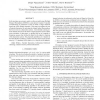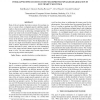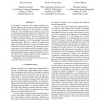8 search results - page 1 / 2 » Speaker Diarization Based on Intensity Channel Contribution |
TASLP
2011
13 years 2 months ago
2011
The time delay of arrival (TDOA) between multiple microphones has been used since 2006 as a source of information (localization) to complement the spectral features for speaker di...
ICASSP
2009
IEEE
14 years 2 months ago
2009
IEEE
In the meeting case scenario, audio is often recorded using Multiple Distance Microphones (MDM) in a non-intrusive manner. Typically a beamforming is performed in order to obtain ...
ICASSP
2008
IEEE
14 years 1 months ago
2008
IEEE
State-of-the-art speaker diarization systems for meetings are now at a point where overlapped speech contributes significantly to the errors made by the system. However, little i...
ICMCS
2006
IEEE
14 years 1 months ago
2006
IEEE
In this paper, we present a new speaker diarization system that improves the accuracy of traditional hierarchical clustering-based methods with little increase in computational co...
TASLP
2008
13 years 7 months ago
2008
Many current state-of-the-art speaker diarization systems exploit agglomerative hierarchical clustering (AHC) as their speaker clustering strategy, due to its simple processing str...



